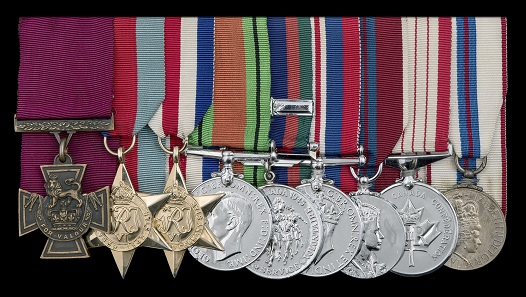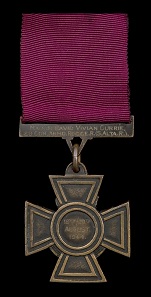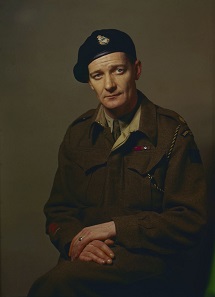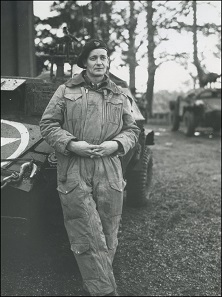May 10, 2018 – On September 27, 2017, the British auction house Dix Noonan Webb could rejoice over a very special sell. The Victoria Cross of the Canadian Lieutenant Colonel David Vivian Currie from the South Alberta Regiment was auctioned for 550,000 CAD. The owner’s widow had sold the cross to a Canadian collector in 1989, who then put the cross up for international auction.
The service ribbon of Lieutenant Colonel David Vivian Currie. Photo: Dix Noonan Webb.
Why this Victoria Cross is something special
The special thing about this object is the fact that only 16 of the 181 bearers of the honourable Victoria Cross from World War II came from Canada. Only 12 of them served in Canadian units. 11 of these 12 orders that went to Canadians in Canadian units are already in museums. Three of the remaining four Victoria crosses are currently on public display in England.
The Victoria Cross of David Currie was thus the only specimen of this order which was given to a Canadian citizen serving in a Canadian unit and one of two Victoria Crosses for a Canadian person which was privately owned and thus available to collectors.
The Victoria Cross. Photo: Dix Noonan Webb.
550,000 Canadian dollars for Currie’s Victoria Cross
This was mirrored by the result. Dix Noonan Webb had estimated the object at 500,000 to 600,000 CAD. This roughly translates to 325,000 to 390,000 euros. The hammer price was 550,000 CAD, or 357,600 euros.
The auction was held with Canadian currency, since Dix Noonan Webb was very aware of the national significance of Lieutenant Colonel David Currie’s order. Canadians were expected to be greatly interested in the order, which was in Canada during the time of the auction. If the successful bidder had been a Canadian, this article would end at this point. But the buyer did not come from Canada but from Great Britain instead. In other words: The order would have left the country at change of ownership.
Lieutenant Colonel David Vivian Currie. Photo: Dix Noonan Webb.
Militaria and mentality
Just like most former members of the British Commonwealth, Canadians tend to have a different attitude towards their military heritage than do other nations. Their programs for commemorative coins are a good example to illustrate this. They do not just feature coins that are generally dedicated to those who fell in the wars but they also address a number of jubilees from events in World Wars I and II.
While army museums are a rare phenomenon in the defeated nations, Germany and Austria, veterans and their merits play an important part in Canadian culture and politics. Just to name an example, the National Council of Veteran Associations, founded between the World Wars in Canada, currently represents more than 60 veteran associations. While regulars have to face a lot of prejudice in European nations, the Canadian army and its local gatherings and transregional events are right at the centre of society.
Orders are still cherished in this society. This is the only way to explain the fact that the Canadian administration in collaboration with members of the army was actually willing to pay a very high sum to take the 12th Victoria Cross back home.
Lieutenant Colonel David Vivian Currie in an armoured reconnaissance car on November 12, 1944 in Halte, Netherlands. Photo: Dix Noonan Webb.
The general public demanded that the Victoria cross stay in Canada
This had been preceded by public criticism. Selling the cross to a foreigner had been received negatively by a large audience. Canadian veteran associations and historians, even family members of people who had once received the order, directly turned to Canadian Prime Minister Justin Trudeau in order to keep the national treasure. The Canadian War Museum in Ottawa had also participated in the auction but they had been outbid. Consequently the Canadian Cultural Property Export Review Board extended the export ban for the ribbon for an additional six months on February 5, 2018. This period of time should be used to raise enough money to pay the victorious bidder off and thus keep the ribbon in Canada.
The money is raised by the state and some sponsors
It was practically another heroic battle, trying to get the funds. There were contributions by the Movable Cultural Property Programs of the Department of Canadian Heritage, the National Collection Fund, and a great donation by the Brownlee Family Foundation. Some honorary members of the North Saskatchewan Regiment and their families also gave large amounts of money. Articles did not cover the total amount of the reimbursement.
Acting as a representative of Dix Noonan Webb, Will Bennett expressed his contentment with this solution: “We knew from the beginning that this was an important object for Canadian identity. That is why we never exported it to London but kept it in Canada instead and – even though we usually hold our auctions in pounds sterling – used Canadian dollars as currency. We are glad that we could come to a mutual agreement, which made everyone happy and left this national treasure in Canada.”
The 12th Victoria Cross will be made accessible to the public. While the German Military Museum banks on subjects like “gender and violence”, the Canadian War Museum in Ottawa will designate a very special place of honour to this highlight of phaleristics.
If you would like to know more about the historic background, please have a look at the information collected by Dix Noonan Webb.
The auction house Dix Noonan Webb is a specialist for coins, orders, militaria and jewellery.
Wikipedia offers a lot of information on the Victoria Cross.
Here you will find a contemporary film on the awarding of the Victoria Cross to Currie.
The Ottawa Citizen is one of the media which have reported on the journey of the Victoria Cross in Canada.
The exhibition “gender and violence” actually exists. You can see it for yourself at the website of the German Military Museum.
Incidentally, the online catalogue of the Heeresgeschichtliches Museum in Vienna does not feature orders either, at least for now.








